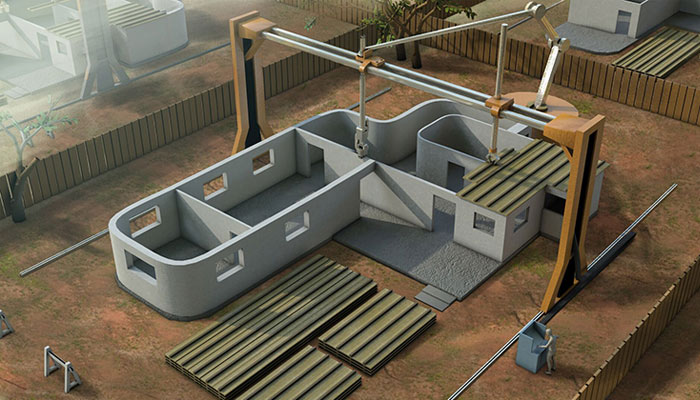The Advancement of Infrastructure with 3D Printing Innovations
As we move through the evolving domain of technology, one breakthrough stands notably in the field of construction: 3D printing. This groundbreaking approach is reshaping the manner developments and edifices are designed and built, ushering in a new phase of effectiveness, sustainability, and innovation. Reshaping Construction: One Layer at a Phase The adoption of 3D fabrication in infrastructure presents multiple transformative advantages. Foremost among these is the significant reduction in resource surplus. Conventional construction techniques commonly result in notable waste materials that lead to environmental pollution. In contrast, 3D manufacturing utilizes a precise incremental strategy, using only the required portion of material and thus reducing surplus greatly. Another compelling benefit is the remarkable reduction in construction time. Developments that conventionally require extended durations can be finished in a portion of the timeline with 3D printing systems. This time reduction is due to the mechanized nature of 3D printers that can work continuously without manual assistance, significantly reducing total development deadlines. Moreover, 3D printing unlocks prospects for building intricate, tailored designs at no additional price. The flexibility of 3D devices allows for intricate patterns and structures to be created that would either be exceptionally pricey or impossible to achieve with traditional building techniques. This function not only elevates design visual appeal but also enables designers to maximize plans for superior functionality and longevity.  Reducing Expenditures and Improving Reachability Expense reduction is yet another major benefit brought about by 3D manufacturing in building. By minimizing manpower spending and decreasing the timeline needed to finish projects, the overall expenditure linked to building edifices is reduced. Moreover, cheap 3D fabrication devices are growing more available, placing this method attainable for smaller businesses and entrepreneurs keen to discover its possibilities. The budget-friendliness of these machines also opens opportunities for creativity in connected sectors such as fabric production. While primarily known in construction circles, the scope of 3D printing spans into numerous areas including fashion. Here, creators experiment with 3D fabricated clothing, challenging creative limits and revolutionizing material manipulation while benefiting from minimal fabrication expenses. An Eco-Friendly Era Fueled by Innovation Sustainability is another foundation of this innovation’s value in the construction sector. 3D fabrication supports a environmentally friendly strategy to construction by reducing resource waste and energy consumption. Additionally, it enables the application of green substances like recycled plastics or hybrid mixtures, which further reduces the ecological impact of this traditionally heavy-polluting industry. The global transition in favor of sustainable methods gains a powerful supporter in 3D manufacturing systems, likely reshaping how structural guidelines and criteria are developed going forward. By adopting these advanced processes, the construction field steps closer to achieving sustainable functional models. Turning Dreams to Existence Imagine community hubs in underprivileged areas being erected within a short time to meet pressing demands or visionaries crafting masterpieces reflecting natural structures that harmonize effortlessly into their landscapes – such concepts are not merely speculative but are rapidly becoming achievable through 3D printing. While these achievements mark just the start, they hint at a time where building harmonizes seamlessly with both cultural aspirations and ecological care. If we continue on this path, building will not only mean the physical development of environments but also symbolize a pledge to forward-thinking thinking and responsible existence. Bridging imagination with functionality, 3D fabrication stands poised to transform our physical environment in ways we are just starting to to grasp. Through continual advancements and an embracing of these forward-thinking approaches, our built surroundings will certainly evolve into reflections of societal creativity powered by the precision and boundless capabilities of 3D printing. For more information about may in 3d gia re visit this popular webpage: learn here
Reducing Expenditures and Improving Reachability Expense reduction is yet another major benefit brought about by 3D manufacturing in building. By minimizing manpower spending and decreasing the timeline needed to finish projects, the overall expenditure linked to building edifices is reduced. Moreover, cheap 3D fabrication devices are growing more available, placing this method attainable for smaller businesses and entrepreneurs keen to discover its possibilities. The budget-friendliness of these machines also opens opportunities for creativity in connected sectors such as fabric production. While primarily known in construction circles, the scope of 3D printing spans into numerous areas including fashion. Here, creators experiment with 3D fabricated clothing, challenging creative limits and revolutionizing material manipulation while benefiting from minimal fabrication expenses. An Eco-Friendly Era Fueled by Innovation Sustainability is another foundation of this innovation’s value in the construction sector. 3D fabrication supports a environmentally friendly strategy to construction by reducing resource waste and energy consumption. Additionally, it enables the application of green substances like recycled plastics or hybrid mixtures, which further reduces the ecological impact of this traditionally heavy-polluting industry. The global transition in favor of sustainable methods gains a powerful supporter in 3D manufacturing systems, likely reshaping how structural guidelines and criteria are developed going forward. By adopting these advanced processes, the construction field steps closer to achieving sustainable functional models. Turning Dreams to Existence Imagine community hubs in underprivileged areas being erected within a short time to meet pressing demands or visionaries crafting masterpieces reflecting natural structures that harmonize effortlessly into their landscapes – such concepts are not merely speculative but are rapidly becoming achievable through 3D printing. While these achievements mark just the start, they hint at a time where building harmonizes seamlessly with both cultural aspirations and ecological care. If we continue on this path, building will not only mean the physical development of environments but also symbolize a pledge to forward-thinking thinking and responsible existence. Bridging imagination with functionality, 3D fabrication stands poised to transform our physical environment in ways we are just starting to to grasp. Through continual advancements and an embracing of these forward-thinking approaches, our built surroundings will certainly evolve into reflections of societal creativity powered by the precision and boundless capabilities of 3D printing. For more information about may in 3d gia re visit this popular webpage: learn here